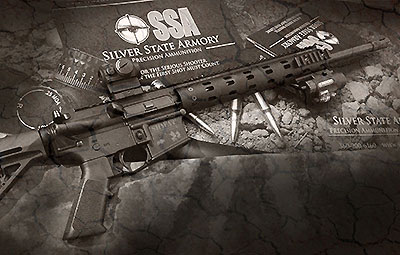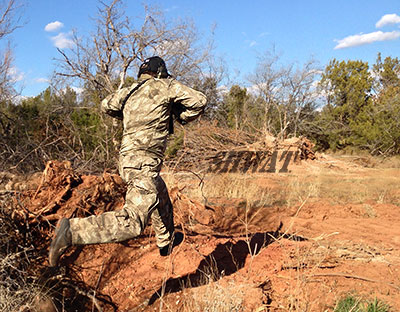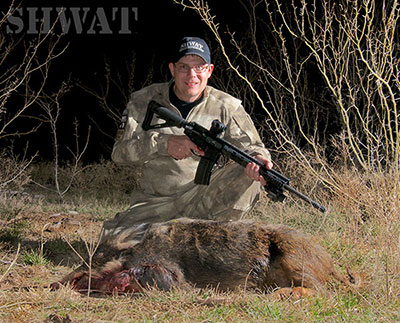
I’d been waiting for this opportunity.
I’d already set up and reviewed the Daniel Defense M4V7 chambered in 6.8 SPCII a couple of months ago. The AR-15 is solid, well made with all the trappings of a top tier mil-spec rifle, and I liked almost everything about it. I won’t repeat my review here, but you ought to check it out along with the photography I did for the article.
I chose the Aimpoint T-1 Micro for an optic. It needed a new home, and for close quarters tactical hog hunting, I like the 1x (no magnification) optics. They are great for both eyes open fast shooting, which would come in handy on this hunt. I had already zeroed with Silver State Armory’s 110 grain TSX round.
What I hadn’t done was go chase wild hogs with this combo, and I was more than a little eager to make that happen.
Opportunity presented itself at one of my favorite places to hunt, the Spike Box Ranch just outside Benjamin, Texas. It borders the land I first hog hunted on, the place where seeds of Special Hog Weapons and Tactics™ were discovered.
Hunting operations at Spike Box are managed by Cash Parrish, who’s assisted by a number of guides who know how to find hogs. Cindy does most of the cooking, and if you didn’t kill any hogs, it would still be worth the trip for her culinary expertise!
That said, I wanted hogs. And I wanted to take them on with the same Silver State Armory 110 grain TSX 6.8 I’d zeroed with a few weeks back. I had less than twenty-four hours on the ranch, and less than that to hunt.
Arriving just past midnight, I connected with NRA Field Editor and SHWAT™ writer Brian McCombie and we headed out on foot for a little night hunt. Honestly, this was a relatively low tech, lets see what happens stalk.
I wanted to get up close without the aid of night vision (NV), IR lasers and illuminators, then laze and light up the hogs with the Insight M6X mounted on my Daniel Defense MFR rail. It was supposed to be a spot and stalk hunt, using a FLIR monocular McCombie brought along, but sadly, there was nothing to spot.
The next morning McCombie and I spent some time filming for another story he’s working on followed by a little hang time with friends at lunch. Greg Ray, President of NRA Outdoors, arranged the hunt. Ben O’Brien, Online Editor for Intermedia Outdoors, and Joe Kurtenbach, Associate Editor at the NRA publication American Rifleman were there, too.
After lunch, McCombie and I meet up with our guide for the afternoon, Ronnie Ainsworth. He’s a retired game warden, knows this land, and knows feral pigs. He drops us off on the edge of a wheat field. The green wheat is no more than three or four inches tall, but hogs like it just fine.
The goal is to cross the field, making our way to a substantial rock face wall fronting a 400 foot or so hill which overlooks our side of the wheat field. There’s a narrow winding line of trees through the middle of the wheat field we use for cover. From the amount of tracks, we know there are plenty of hogs in the area, and we are literally following them to the hill.

When we get to the base of the hill, hog tracks are everywhere. Big hogs, little hogs, mixed with coyote tracks and even some raccoon. Through some relatively thick cedar trees, we hike up and down and half way around this rocky hill, amazed at the amount of hog sign, and highly irritated that they are nowhere to be found.
Ronnie and I drop off McCombie at a stand overlooking a feeder so he can hunt into the night. The two of us then drive the dirt roads looking for hogs. The weather is great, but just a bit cool as the afternoon is getting later. The clock is ticking. The sun is setting and my departure time will soon call me back to the lodge.
Ronnie drives across the highway, into yet another wheat field. On the far side of the field we park with the sinking sun behind us. Last chance for me. We wait. Up to now, I’ve never left the Spike Box empty handed.
Parked a few feet south of an east-west fence on our left, we’re hoping to see hogs come out to feed in the last light. The fence separates the wheat field on the south side from woods on the north. And sure enough, a dozen pigs wander out from the trees about 500 yards in front of us!
I am excited! This is what I came for. I forgot to take a picture.
The wind has died down and it’s quiet. Ronnie sits tight with his binos while I quietly exit the truck. I think he’s as excited for me as I am. This never gets old.
There is a thin outcropping of trees stretching beyond the fence into the field about 400 yards ahead of our position. The hogs are on the far side of that outcrop, and moving south more into the open as they feed. I want to get my shot from the cover of that vegetation.
The fence line I’ll hold closely to is unbroken to the east as far as I can see, but the tree line has gaps. I’m glad to be wearing some brand new A-TACS camo (Advanced Tactical Concealment Systems). It looks great, is super high tech using mathematical algorithms to create organically shaped pixel patterns that don’t look pixelated. So, yeah, that’s all a bit beyond me, but it looks cool and has some serious tactically credentialed users around the world. I’m just hoping it will help me move undetected four hundred yards east to my firing point.
Following the fence line east I methodically close distance, pausing periodically to take stock of the situation. The hogs are now all very much in the open, downing the Spike Box wheat before it can grow much. Hogs are happy. I’m happy.
I make it to the outcrop of trees. Note that this is West Texas, and we’re talking thin scrubby mesquite trees, dark with spindly trunks and branches devoid of leaves. There’s no wall of stately green for good concealment here.
I move to the edge of this minor league stand of trees where the wheat field begins. I should be plainly visible to the hogs at this point, and one is staring right at me. He remains undisturbed. He’s pretty good sized. Two hundred plus pounds. Next to him is another hog about the same size. I kneel, put my Aimopint’s single red dot on the pig, and plan to make a heart/lung shot.
 Trigger squeeze, then the long “boom” as the 6.8 SSA TSX bullet heads down range. Whap! Ronnie later confirms the hit, but that big pig slips across the fence line to breath its last back in the trees, back across the fence line we cannot cross. Now that is irritating.
Trigger squeeze, then the long “boom” as the 6.8 SSA TSX bullet heads down range. Whap! Ronnie later confirms the hit, but that big pig slips across the fence line to breath its last back in the trees, back across the fence line we cannot cross. Now that is irritating.
Eleven other hogs simultaneously split in three directions. One group heads immediately back across the fence line with their buddy into the woods. They must be the smart ones. Another group heads almost directly away at full speed.
The third group moves out to my right, to the south in the opposite direction of any cover. They are smaller hogs. Realizing the error of their way, they turn and head right back at me.
I love this situation, as I now stand between hogs and their cover. I’ve been in it before, and it’s a rush. It’s part of what makes tactical hog hunting so much fun! The hogs are moving fast – really fast. After a couple of shots over its shoulder, I connect with the lead hog at fifteen yards, and the 6.8 does it’s job. Fifteen yards later, it’s down, twitching, kicking, but lights out.
The sun has just set, and Ronnie is driving down. My little hog can’t be more than 125 pounds, but it provided way more than that in excitement. Everything worked exactly as it should have. My A-TACS camo gear was comfortable and functional, my Daniel Defense M4V7 ran perfectly, the Aimpoint unobtrusively did its job, and the 6.8 TSX from Silver State Armory finished the hunt out nicely. I can’t wait to do this again!

